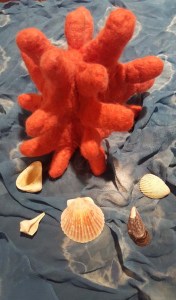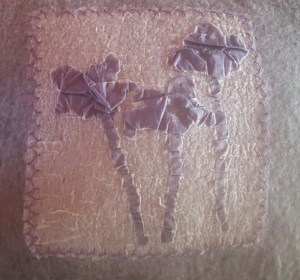Botanical Printing Fun
Autumn has definitely arrived in my little corner of the world, the trees are turning breath-taking shades of red, gold and orange and starting to fall to the ground.
This week I met with two friends who I normally meet every couple of months for a felting play-date but we couldn’t pass up the perfect opportunity to use the abundance of natural materials at our feet and have a go a botanical printing. Not something any of us are experts in but its always fun to try new things isn’t it?
I have been playing with botanical printing for a couple of years now, so I already had a selection of materials to hand (rusty water, logwood extract, a tea urn and fish kettle for steaming etc) but Janine and Nancy also brought materials (red onion skins, another fish kettle, hot plate etc) with them, along with the all important vegetation and mordanted fabrics.
After looking through some of my previous attempts we settled on a logwood carrier blanket for the first attempt. The leaves were dipped in iron water before laying on our fabric, covering with the logwood-soaked carrier blanket and steaming. These were our results…
Janine’s dye blanket was smaller than the fabric she was printing, I love how her leaf prints appear to be breaking free from their logwood “frame”:

I loved the greens Nancy achieved with jasmine and rose leaves:

This was my silk scarf part way through the reveal…. logwood blanket with leaves still stuck to it on the left, printed scarf on the right. I was a little disappointed with the eucalyptus leaf in the top centre of the picture, I have previously achieved some lovely orange prints from this tree but not today.

My silk scarf revealed….

Never one to make life simple, I added a previously printed nunofelt scarf to the other side of my logwood blanket. I was reprinting it because I did not like the original, insipid print, but I like the over-print even less! 🙁

Now it is dry it arguably looks even worse! Not to my taste at all. Yuk!

Next we tried a dye bath (as opposed to steaming our bundles), we mixed a sweet-smelling concoction of eucalyptus bark and red onion skins:

I thought most of the leaf print results from this batch were a little disappointing (only the cotinus appeared to work) although we did get some nice shibori style stripes. The colour difference between the alum-mordanted and unmordanted silk was striking, mordanting really does yield brighter colours.
We sprinkled dried safflower petals among the iron-dipped leaves before bundling and simmering for 90 minutes.




Nancy had better luck with a second piece of cotton in her bundle:

Finally we tried soaking our fabric in tea and using an iron-soaked carrier blanket, the tea gives a gentle yellow-brown colour but where the iron reaches the tea, it turns almost black:
I was quite surprised by how much the colour of the leaf contributed to the colour of the print, in previous tests I found the orange and red leaves gave yellow and brown prints, just like the yellow leaves…. this really is a craft that relies on serendipity!

Another surprise was the beauty of the iron carrier blankets, they really stole the show!



Nancy also had a promising looking result from a heuchera leaf

But when the leaf was removed the print underneath was a little disappointing…

Our final bundles of the day were arguably the best. Janine and I used some large fatsia leaves and I included some wisteria that Janine had brought, this gave one of the most beautiful greens I have ever achieved from a botanical print. We dipped the leaves in iron water and used a logwood carrier blanket again.

While I love the white silhouette effect of the large fatsia leaf on my scarf, I am in awe of the detailed print Janine achieved from hers…


Feeling inspired by the wonderful greens Nancy’s jasmine had given, I carried on after they left, pruning my poor garden far more than it really needed 🙂 However, while the maple and liquid amber leaves printed beautifully, my jasmine wasn’t as pretty as Nancy’s:

I included a nunofelted scarf on the other side of this dye blanket too and was pleased with the colours from the sycamore and oak leaves, I think the yellows work beautifully next to the blue-grey background:

I also put another bundle in the red onion and eucalyptus bark dye pot, but this time it was simmered for 2 hours, and I think the leaf prints were much improved from the extra 30 minutes of cooking:

Thinking of having a go yourself? You should, its a lot of fun if you like unwrapping presents! You can never really know what you will get 🙂
All but one of the scarves / fabrics in this post were steamed or simmered for 90 minutes, however, I found simmering in the dye bath yielded better results if they were left in for at least 2 hours. I know some botanical printers steam for a lot longer or leave their bundles to cool overnight before unwrapping, but I never have the patience to do that! 🙂
All the leaves were placed with the veins facing the fabric to be printed, in theory the stomata (the holes that the leaf “breathes” through) on the leaf underside should give a better print as there is more opportunity for the tannins to be released, but the prints on the iron blanket (they are printed from the top of the leaf) were equally stunning, I will leave it to you to experiment with that and see which works best.
In most cases (not when the iron blanket was used) we dipped the leaves in iron water before laying on the fabric.
All fabrics were gently washed after printing to remove the iron and organic material.





























































































































































